This was published 1 year ago
Stranger than fiction: Why are we so mad for memoirs?
Australian sales of memoirs have more than doubled in 20 years. What’s behind our insatiable appetite for them?
By Jane Cadzow
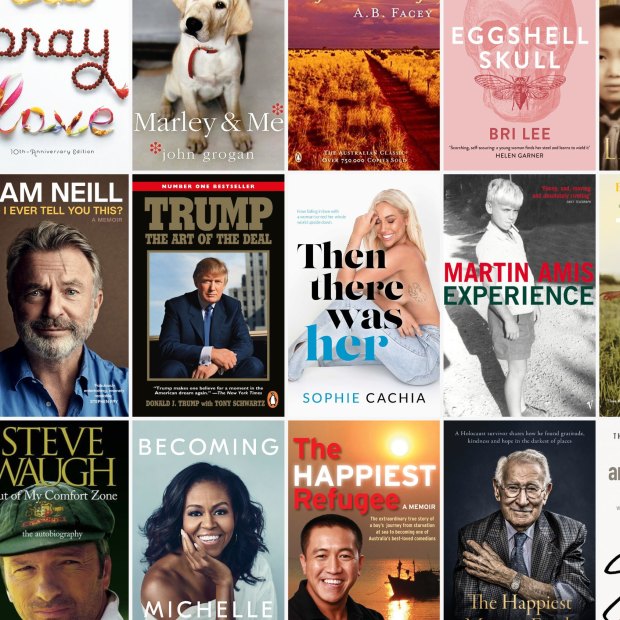
In 2003, Australians bought 833,000 memoirs. In 2022, we bought two million of them.
A CONFESSION: Until I started researching this story, I had not heard of Sophie Cachia. In case you’re as ignorant as I was, let me fill you in. Cachia is the 32-year-old co-founder of a Melbourne-based sleepwear business: she sells pyjamas online. She has a lot of Instagram followers. Also, she’s been a contestant on the reality TV show Australian Survivor. She has two children with former AFL player Jaryd Cachia. Their marriage ended after Sophie realised she was attracted to women. She decided to write a memoir.
Then There Was Her was released last year by the Australian division of the international publishing firm Simon & Schuster. To be candid – and candour is the currency of memoir, so let’s go for it – this is not the kind of book that wins literary awards. “I f---ing hate sitting here writing about myself from 20 years ago,” Cachia tells us in the section of the memoir that deals with her teenage years. She is happier writing about her newfound bisexuality and the soul-searching it initially prompted. “Sophie, what the f---?” she asks herself after applying fake tan and false eyelashes in preparation for meeting a female footballer on whom she’s developed a major crush. “Why do you feel like this?”
The self-addressed questions keep coming as thrilling affairs are followed by anguished break-ups (“Did it hurt like hell? Yes, it absolutely f---ing did”). Because I read the book quickly, I sometimes lost track of the various unnamed girlfriends and scrambled to keep up with Cachia’s swings of emotion as she ricocheted from one relationship to another. “What the f--- was going on?!” she writes at one point.
“No f---ing idea,” I felt like replying.
The memoir was such a commercial success that Simon & Schuster commissioned a follow-up. Then There Was You, released in June this year, is a collection of stories by women inspired by Cachia to make similar revelations about their own lives. In the foreword, Cachia says she was overwhelmed by the positive response to the first book. “I had thousands of people reach out to personally say thank you …”
“I think we want to make contact. We want to feel. We want to hear their stories on a personal level.”
Cheryl Akle, founder, Better Reading
As a nation, we can’t get enough of this stuff. According to Nielsen BookScan Australia, our appetite for memoirs has more than doubled in the past two decades. In 2003, Australians spent $21 million on 833,000 books in the category. In 2022, we paid $53 million for two million of them. And it’s not just the number we’re buying that’s increased. The range has grown significantly, too. In 2013, more than 8000 different memoir titles were bought in this country. If that sounds like a lot, consider that in 2022 we snapped up more than 15,000 titles. Search Amazon for memoirs and you’ll get more than 60,000 results, ranging in mood from Bonkers: My Life in Laughs by English actor Jennifer Saunders to Anger is My Middle Name by Danish social policy activist Lisbeth Zornig Andersen. We live in an age of memoir-mania.
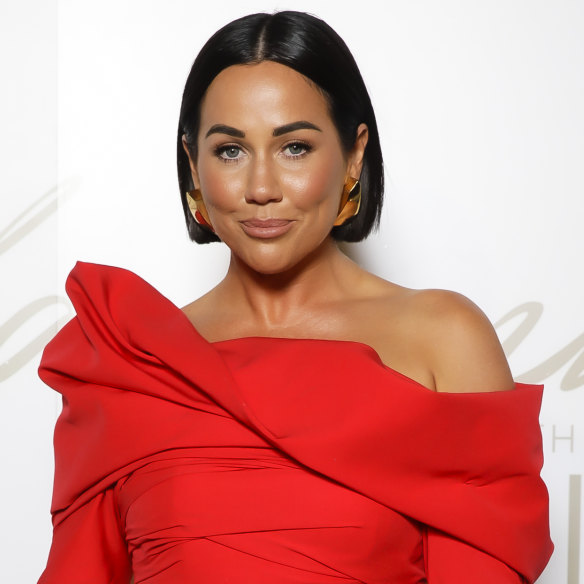
Influencer, entrepreneur and reality TV show contestant Sophie Cachia, 32. Her memoir was published last year.Credit: Getty Images
To literary agent Benython Oldfield, the appeal of the genre is obvious. “A memoir, because it’s true, can be more moving and more emotionally powerful than fiction,” says Oldfield, a Sydney-based director of Zeitgeist Agency. “People enjoy walking in someone else’s shoes and being deeply affected by the experience.” Cheryl Akle, founder of online book lovers’ community Better Reading (which has 365,000 Facebook followers), wholeheartedly agrees: memoirs offer a sense of connection with the human race that cannot as easily be found in fiction. In essence, reading a memoir is
accepting a stranger’s offer to confide in you, Akle says. “It’s like sharing a secret. It’s intimate.”
Her own preference is for the type of memoir that focuses on a particular aspect of the writer’s life rather than the sweeping chronological sagas that used to be known as autobiographies. (They’re all called memoirs now. As G. Thomas Couser says in his 2011 book Memoir: An Introduction: “We have not experienced an autobiography boom, but a memoir boom. No one writes autobiography any more. At least, no one reads it.“) It seems to Akle that most people who pick up a memoir aren’t looking for exhaustive biographical detail. We aren’t even looking for entertainment, necessarily. “I think we want to make contact,” she says. “We want to feel. We want to hear their stories on a personal level.”
First-hand accounts of grief and loss never meant more to Akle than when her mother was dying in a Sydney nursing home. As she sat at the bedside in that final week, she read books by two fine Australian writers: Helen Garner’s How to End a Story: Diaries 1995-1998 and Chloe Hooper’s Bedtime Story. “They gave me great comfort,” Akle says. “It was as if they were both in the room with me, telling me the stories of their lives. I have a feeling that in 20 years’ time, my memory of my mother’s death will be that Chloe came, and Helen came. I was with two very good friends.”
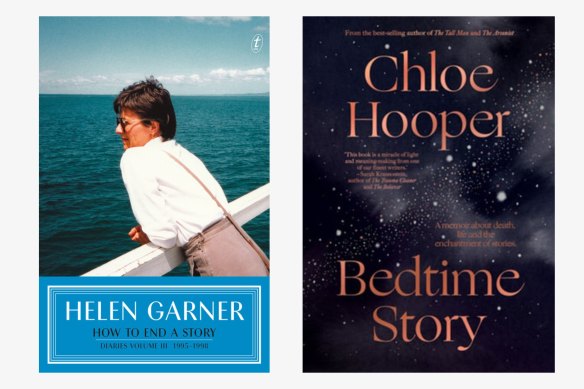
Two books that gave great comfort to Better Reading founder Cheryl Akle while sitting at her mother’s bedside: “My memory of my mother’s death will be that Chloe came, and Helen came. I was with two very good friends.”
The best memoirists are boon companions. They delight us. They console us. They enhance our own lives by letting us into theirs. The worst memoirists are like annoying guests at dinner parties who won’t stop talking about themselves. Their struggles, their triumphs, their childhood. Especially their childhood. “But enough about me,” you long for them to say. Most memoirists are somewhere between those two extremes. Neither brilliant nor batshit boring, they’re just there. Hordes of them. In his own memoir, Experience, the English writer Martin Amis sardonically recalled the axiom that everyone has a novel in them. “What everyone has in them, these days,” he wrote, “is not a novel but a memoir.”
For quite a while, the trend has rung alarm bells in some quarters. In a 2011 book review for The New York Times, journalist Neil Genzlinger wistfully remembered a time when the only people who had memoirs published were those who had earned the privilege – by accomplishing something noteworthy, say, or having an extremely unusual experience. Everyone else kept their life stories to themselves. “Unremarkable lives went unremarked upon, the way God intended,” Genzlinger wrote. “But then came our current age of oversharing, and all heck broke loose.”
Many authors listed on Amazon would have qualified as memoir-eligible under the old rules, he pointed out. Unfortunately, they were “lost in a sea of people you’ve never heard of, writing uninterestingly about the unexceptional”. Genzlinger concluded that three of the four memoirs he’d been assigned to review in the article need not have been written – a ratio he suspected applied to memoirs generally.
Soon after, in The New York Review of Books, writer Lorrie Moore set out some questions for prospective memoirists to consider before raising a finger to the keyboard: “Are you connected to a fascinating and under-explored chapter in history in any manner whatever? Are you a professional storyteller with a beautiful prose style and some autobiography begging for reportage? Are you a trenchant thinker with incisive analytical powers? Do you have a social cause you would like to advocate strenuously? And if none of the above, are you Brigitte Bardot?“
You might have noticed there’s nothing on that list about selling sleepwear or appearing on Survivor. I think I know what Sophie Cachia would say. What the f---?
Memoir-writing was once left mainly to blokes. Old blokes. Retired cricket captains looking back on their glorious innings. Former prime ministers defending their record and sinking the boot into rivals. Superannuated rock stars trying to remember what they did in the 1960s. Eddie Jaku, a Holocaust survivor who settled in this country after World War II, published his memoir at the grand age of 100. The Happiest Man on Earth came out in 2020, the year before Jaku died. It was the bestselling memoir in Australia in both 2021 and 2022.
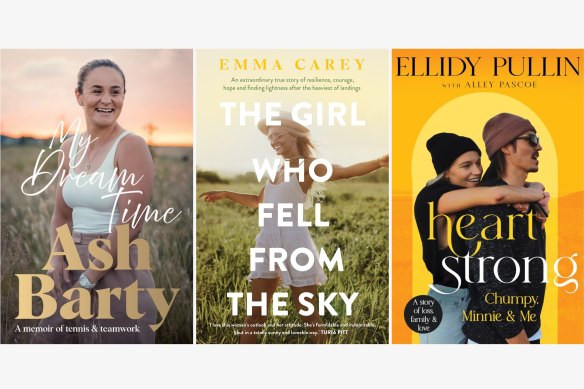
Three “super-fascinating” memoirs by Australian women, according to Helen Littleton, head of non-fiction publishing at HarperCollins Australia. “These are ordinary but extraordinary young women telling these really raw, personal stories.”
Change is afoot. A new generation of memoirists charged into the sales charts last year, led by 27-year-old tennis champion Ash Barty. Her memoir, My Dream Time, released in November (and ghostwritten by Good Weekend’s Konrad Marshall), is believed to have sold more than 90,000 copies. Helen Littleton, who as head of non-fiction publishing at HarperCollins Australia was responsible for producing Barty’s book, points to three other young female authors who made an impact in 2022. In The Girl Who Fell From the Sky, published by Allen & Unwin, Emma Carey told of rebuilding her life after a skydiving accident. In Heartstrong (Hachette Australia), Ellidy Pullin wrote about the sudden death of her partner and the subsequent conception of their daughter through IVF treatment with posthumously retrieved sperm. Sophie Cachia’s memoir also caught Littleton’s attention. “I think those three books are super-fascinating,” she says. “These are ordinary but extraordinary young women telling these really raw, personal stories.”
“I say to [memoir-writers], ‘If you want a bestseller, you have to be braver than maybe you want to be – more open than you want to be.’ ”
Helen Littleton, head of non-fiction publishing, HarperCollins Australia
What the three have in common, apart from youth and beauty, is a big presence on social media. Cachia has 261,000 Instagram followers, Pullin 255,000 and Carey 190,000. (Both Cachia and Pullin are professional influencers, sprinkling their posts with paid product endorsements.) From a publisher’s point of view, this meant a ready-made pool of potential book-buyers. The other advantage? The women were accustomed to shining a spotlight on themselves. Littleton says many memoir-writers have to be coaxed to be frank and forthcoming: “I say to them, ‘If you want a bestseller, you have to be braver than maybe you want to be – more open than you want to be.’ ” But memoirists who are instagrammers, bloggers and podcasters are accustomed to communicating with their followers in an unfiltered way. “They are totally used to putting everything on the table.”
During my research, I come across a post from Cachia’s former blog, The Young Mummy. Describing sex with her husband during late-stage pregnancy, she wrote: “I can’t help but feel like he’s rooting a dead warthog.” Okay, I see what Littleton means.
For most of the 20th century, memoirists were expected to keep things light and breezy. In his 2009 book Memoir: A History, Ben Yagoda cites the huge popularity in the US in the 1930s of Life with Father and Life with Mother, Clarence Day’s affectionate portraits of his upper middle-class family. Day suffered from such crippling arthritis that he could write only with the aid of a pulley system, yet his stories were unremittingly sunny. And funny. “If Clarence Day were embarking on a memoir today, it would in all likelihood centre on his battle with arthritis,” Yagoda writes. “In Life with Father and Life with Mother, he does not even mention the ailment.“
Addicted to heroin? Raised in a cult? Lost your entire family in a freak accident? Don’t worry, there’s a book for that.
Everything changed in 1996, when US high-school teacher Frank McCourt published Angela’s Ashes, the Pulitzer Prize-winning memoir of his ghastly Irish childhood. With help from Dave Pelzer’s A Child Called ‘It’, a tale every bit as grim as the title suggests, McCourt’s book ushered in the era of the so-called “misery memoir”. Child abuse – emotional, physical and sexual – was the central theme. Suddenly the non-fiction shelves in bookstores were groaning under the weight of paperbacks with pictures of waifs on the covers and titles like Please, Daddy, No.
Over time, the category expanded to encompass every kind of trauma and despair. Addicted to heroin? Raised in a cult? Lost your entire family in a freak accident? Don’t worry, there’s a book for that. Both writer and reader were supposed to find the exercise therapeutic. The Americans ate it up, natch. The Brits wallowed in it. We read our fair share of misery-lit in Australia, too, but it didn’t take hold here in quite the same way. On the whole we seem to prefer our memoirs upbeat, especially if the author keeps smiling through adversity. Eddie Jaku’s The Happiest Man on Earth has sold more than 338,000 copies in this country, making it the third-highest selling memoir since Nielsen BookScan Australia records began in 2002. Just behind it, in fourth place, is The Happiest Refugee, by Anh Do, which has sold 316,000 copies.
At the top of Nielsen’s list, with sales of 565,000, is Eat, Pray, Love, American writer Elizabeth Gilbert’s 2006 account of her year-long trip around the world after her divorce. In second place is Mao’s Last Dancer, in which Li Cunxin tells of his journey from abject poverty in rural China to performing on the great ballet stages of the world. Li immigrated to Australia in 1995 and published his memoir in 2003. At the time, he and his wife expressed doubts that anyone other than family and friends would want to read it. In the event, the book sold 426,000 copies and was made into a movie. (Li, 62, recently announced his retirement as Queensland Ballet artistic director.)
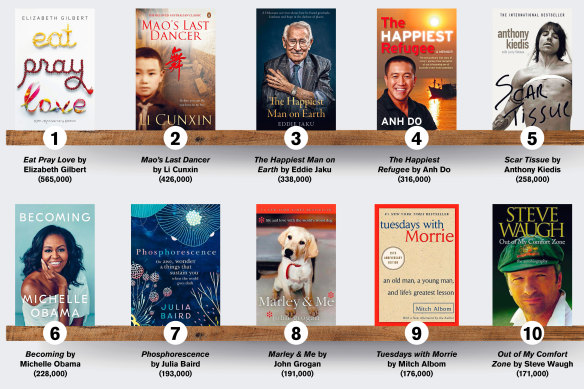
The top-selling memoirs of the past two decades in Australia, according to Neilsen BookScan.
The memoir that has imprinted itself most firmly on the national consciousness was written by a man with no formal education. A.B. Facey was eight years old when he started work as a farmhand in Western Australia. His father had died before he was two and his mother had deserted him soon afterwards. Facey taught himself to read and write in his teens, then fought at Gallipoli, where two of his brothers died. His son was killed in World War II. His simply told life story was published in 1981, nine months before his death at the age of 87. As his entry in the Australian Dictionary of Biography puts it, “the style of the book passed beyond plainness into an elemental purity”. Facey became an instant folk hero, admired for his decency and dignity, and for the fact that he hadn’t written a misery memoir. According to the publisher, Fremantle Press, A Fortunate Life has sold more than one million copies.
Sigmund Freud, the founder of psychoanalysis, hated the idea of writing a memoir. “That is of course quite an impossible suggestion,” he wrote to the nephew who, in 1929, conveyed a publisher’s proposal that he do so. As Freud saw it, giving a complete and honest account of his life “would require so much indiscretion … about family, friends and enemies, most of them still alive, that it is simply out of the question”.
Upsetting their near and dear is an occupational hazard for memoirists. Some authors try to minimise the damage. Others let rip. In Running With Scissors, US writer Augusten Burroughs wrote of being sent by his mentally unstable mother to live with her psychiatrist, who turned out to be unhinged himself. Burroughs depicted the doctor, his wife and their kids as a gruesome crew who lived in squalor and kept an electroshock machine under the stairs. The Turcotte family – whose name he changed in the book – sued for defamation, invasion of privacy and emotional distress, arguing that the 2002 memoir was more fiction than fact (and that the machine under the stairs was an old Electrolux vacuum cleaner). The case was settled in 2007, when Burroughs made concessions including agreeing to alter the acknowledgments page in future editions to recognise that he and the Turcottes remembered things differently.
“What makes all autobiographies worthless is, after all, their mendacity,” Freud told his nephew. Memoirists fudge facts for all sorts of reasons. To make stories more dramatic. To settle scores or protect people’s feelings. To fill the gaps where memory fails them. Literary agent Tom Gilliatt says readers readily accept that no one has perfect recall: “We’re willing to suspend our disbelief if somebody quotes word for word a conversation they had 20 years ago. It’s a reconstruction. We’re happy with that.”
There are limits, though. “You don’t expect actual fraud,” says Gilliatt, who had senior roles in publishing before joining the Sydney-based Left Bank Literary agency last year. While at Pan Macmillan, he published The Spying Game, a memoir by Sydney private investigator Frank Monte. In the book, Monte falsely claimed to have been employed by Italian fashion designer Gianni Versace, who was murdered in 1997. The Federal Court ruled in 2002 that Monte had defamed members of the Versace family by implying they were involved in organised crime. For Gilliatt, the whole thing was a nightmare. “We withdrew the book, apologised profusely and were hugely embarrassed,” he says.
Soon afterwards, the Australian publishing industry was hit by a bigger memoir scandal. Norma Khouri’s Forbidden Love centred on the murder of her best friend in Jordan. In 2004, a year after the book was published, journalist Malcolm Knox revealed in The Age and The Sydney Morning Herald that the story was fabricated. Khouri’s audacity approached that of a Belgian woman, Misha Defonseca, who in 1997 published a memoir about surviving the Holocaust as a young Jewish girl by trekking alone across occupied Europe, sometimes living with wolves. It turned out that Defonseca’s real name was Monique de Wael. She wasn’t Jewish. She had spent the war safely in Brussels. (The deception is the subject of a 2021 documentary, Misha and the Wolves.)
To G. Thomas Couser, it is no surprise that the memoir boom has coincided with a boom in hoaxes. “A seller’s market for true stories will stimulate the production of false ones,” he writes in Memoir: An Introduction. “… Greed is a strong motivator. And not just for writers: there’s little incentive for publishers to challenge memoirs’ truthfulness.”
Tom Gilliatt believes publishing companies want to do the right thing. The problem is, they’re perennially short-staffed. “There aren’t the spare bodies to do significant fact-checking,” Gilliatt says. In July, allegations of lies and inaccuracies led to the withdrawal from sale of Christophe Glasl’s memoir Special Operations Group: The Inside Story of the Most Feared and Fearsome Unit in Australian Policing. Louise Stark, chief executive of the book’s publisher, Hachette Australia, declined a request for an interview.
Prince Harry didn’t actually write the thing, of course. By his own admission, he’s “not really big on books”.
Soon after its release in January, Prince Harry’s memoir Spare was declared by Guinness World Records to be the fastest-selling non-fiction book of all time. On publication day, it sold 1.43 million copies in print, digital and audio formats, easily beating the record set by Barack Obama’s third memoir, A Promised Land, which sold 887,000 copies on its first day. Spare went on to sell 3.2 million copies in a week (including 64,150 print copies in Australia), no doubt sending champagne corks popping at Penguin Random House. The publisher had reportedly paid the disgruntled scion of the House of Windsor an advance of $US20 million (about $31 million).
Harry didn’t actually write the thing, of course. By his own admission, he’s “not really big on books”. Like most celebrities contracted to publish memoirs, he hired a ghostwriter – in his case one of the best in the business: US novelist and Pulitzer Prize-winning journalist J.R. Moehringer, whose previous efforts included Open, the acclaimed memoir of retired tennis player Andre Agassi. Moehringer’s own memoir, The Tender Bar, became a 2021 movie directed by George Clooney and starring Ben Affleck. In Spare, he makes rich, privileged, petulant Harry seem not only likeable but deserving of sympathy. A remarkable feat.
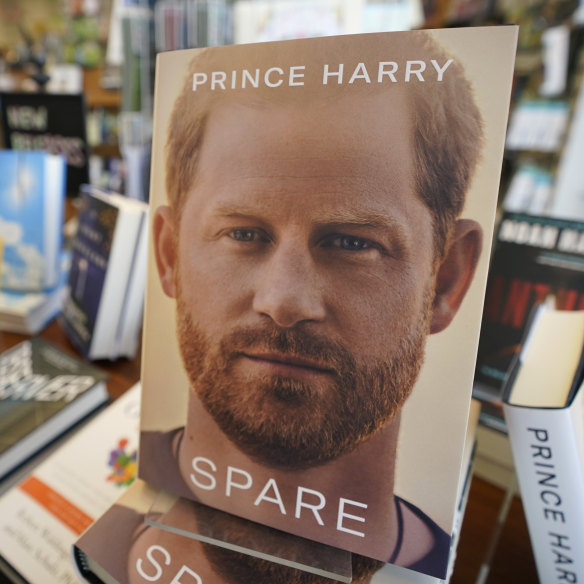
Prince Harry’s Spare: the fastest-selling non-fiction book of all time.Credit: AP
American journalist Tony Schwartz worked similar magic in Trump: The Art of the Deal, the bestselling 1987 memoir that catapulted a dodgy New York property developer to international fame, recasting him as a Midas-like business tycoon. When Donald Trump announced in 2016 that he was running for US president, his erstwhile ghostwriter was appalled, fearing he had created a monster. “I feel a deep sense of remorse that I contributed to presenting Trump in a way that brought him wider attention and made him more appealing than he is,” Schwartz said at the time, adding: “I genuinely believe that if Trump wins and gets the nuclear codes, there is an excellent possibility it will lead to the end of civilisation.”
The consequences of ghostwriting are rarely as catastrophic as that, but it makes a nice change to come across a memoir – such as New Zealand actor Sam Neill’s recent Did I Ever Tell You This? – that is genuinely the work of the person whose familiar face is on the cover. “Sales of Sam Neill’s memoir will tell you that people are very interested in reading about movie stars,” says Allen & Unwin publisher Jane Palfreyman. “Famous people telling stories about their lives will always be popular. Particularly if it’s done in a charming way, with a bit of gossip.”
Better Reading founder Cheryl Akle believes our ever-increasing fondness for memoirs is a major contributor to growing sales of audiobooks. “Memoir and audiobooks go hand-in-hand,” she says, “because often it’s the author reading it, and that’s beautiful.” Both Harry Windsor and Sam Neill did the honours for their books. Michelle Obama did a great job of reading her memoir Becoming, which has sold 228,000 print copies in Australia. But Akle can’t go past Irish actor Gabriel Byrne’s lyrical rendition of his memoir Walking with Ghosts, to which she listened in instalments while walking her dog. She says the walk was longer than usual the day she got to the final chapter. “I couldn’t come home. I had to stay out there because I wanted to finish it.”
Traditionally, having a memoir published was a career’s crowning achievement. It meant you’d made it. Now, writing a memoir can launch a career. In Eggshell Skull, Bri Lee told how her stint as a judge’s associate in the Queensland district court led her to pursue justice in a case of her own. The book hit stores in 2018 when Lee was 26, and surprised many in literary circles by becoming a bestseller. “It went against everything we’d been taught, which was that young people didn’t really write memoirs and most people didn’t want to read about childhood trauma,” says its publisher, Jane Palfreyman.
For Lee, the memoir was a springboard to further success as an author and journalist. For the Australian publishing industry, the book was a game-changer. Palfrey-man says the lesson from Eggshell Skull was clear: “There was a whole hungry market of young female readers, keen to know about other young women’s experiences in the world.”
The experiences of young men can make equally compelling reading, Palfreyman discovered when in 2021 she published Brandon Jack’s 28: A Memoir of Football, Addiction, Art, Masculinity and Love. “It’s a book about how he didn’t make it as a sportsman,” she says. “It was fantastic, and incredibly well received. I feel like the new generation of readers is much more accepting of, and interested in, what might previously have been perceived as weakness.”
“Nobody memoirs”, as life stories by the non-famous are sometimes cruelly called, have considerable appeal for publishers.
“Nobody memoirs”, as life stories by the non-famous are sometimes cruelly called, have considerable appeal for publishers. For a start, they’re cheaper to produce than celebrity memoirs because nobodies aren’t paid multimillion-dollar advances. And they’re easier to promote than debut novels. Excerpts of nobody memoirs get published in magazines like this one. A clever publicist might wrangle radio or TV appearances for a nobody memoirist with a powerful story to tell, whereas no one wants to interview a first-time novelist. (As an editor was quoted as saying, “What would they talk about? Character development?“)
It used to be accepted that in all but exceptional circumstances – unless you were Jimmy Barnes, say, or Barack Obama – one memoir per person was enough. Not any more. The modern memoirist needs little encouragement to produce a second volume. Or a third. And why stop there? Brisbane-based writer Kris Kneen has released four memoirs, the latest of which is Fat Girl Dancing. Kneen is scheduled to lead two memoir-writing workshops at the Melbourne Writers’ Festival next May: tickets for the first workshop sold out almost immediately and the second is filling fast.
Coaching would-be memoirists has become an industry in itself. Guidebooks include Memoir Writing for Dummies, and Ready, Set, Memoir! The Essential Guide to Telling Your Story. Online courses abound. “You can download ‘How Do I Write a Memoir?’ and off you go,” says Fiona Inglis, managing director of literary agency Curtis Brown Australia. Inglis laughs. “That’s why there are too many books being published.“
Towards the end of Then There Was Her, Sophie Cachia hints that the memoir may not be her last. “This isn’t, ‘And Sophie lived happily ever after,’ by the way,” she writes. “My life isn’t wrapped up in a pretty bow. I haven’t found my forever – because how can one know what the f--- forever looks like?”
How indeed? I’d have liked to discuss this point with Cachia but her publisher said she wasn’t available. Too busy, perhaps. Those pyjamas don’t sell themselves. Or perhaps she f---ing hates talking about the f---ing book. Either way, good for her.
To read more from Good Weekend magazine, visit our page at The Sydney Morning Herald, The Age and Brisbane Times